Preliminary Design Tools for Hydrodynamic Aspects of Submerged Impermeable Breakwaters
Abstract
1. Introduction
2. Methods
2.1. The BEM for a Fully Nonlinear Wave Flume with Impermeable Structures
2.2. The Geometry of Filled Geotube Structures
2.3. The OpenFOAM Model for Validation
2.4. Sliding Index
3. Results and Discussion
3.1. Verification of Wave Loads
3.2. A Practical Design Example
4. Conclusions
Author Contributions
Funding
Institutional Review Board Statement
Informed Consent Statement
Data Availability Statement
Conflicts of Interest
Appendix A

- (a)
- Spatial periodic boundary condition (at two vertical boundaries):
- (b)
- Linear radiation condition:
- (c)
- Artificial damping region:
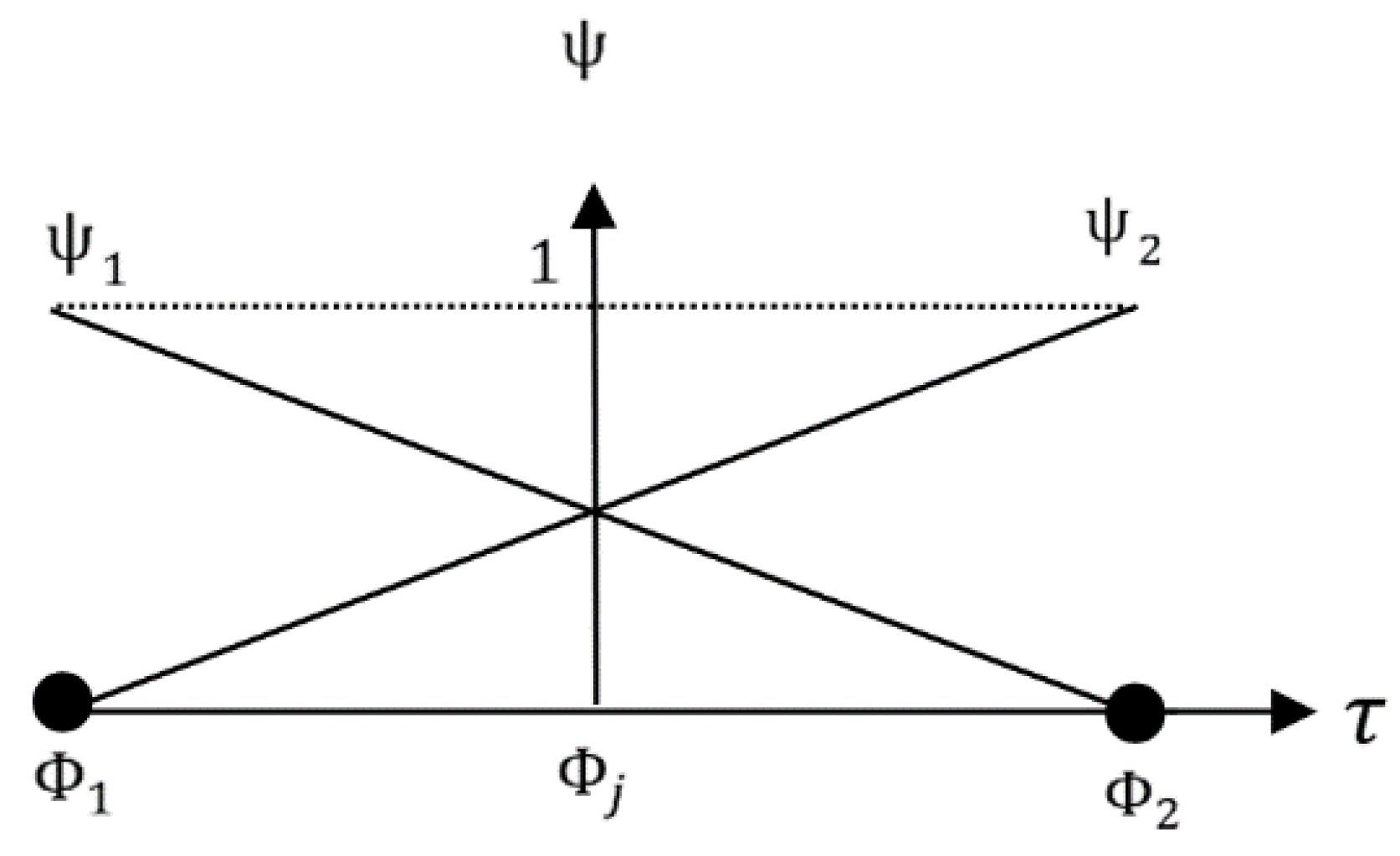



References
- Burcharth, H.F.; Zanuttigh, B.; Andersen, T.L.; Lara, J.L.; Steendam, G.J.; Ruol, P.; Sergent, P. Coastal Risk Management in a Changing Climate. Chapter 3—Innovative Engineering Solutions and Best Practices to Mitigate Coastal Risk. In Coastal Risk Management in a Changing Climate; Butterworth-Heinemann: Oxford, UK, 2015; pp. 55–170. [Google Scholar]
- Zhang, C.; Magee, A.R. Effectiveness of Floating Breakwater in Special Configurations for Protecting Nearshore Infrastructures. J. Mar. Sci. Eng. 2021, 9, 785. [Google Scholar] [CrossRef]
- Gao, J.; Ma, X.; Dong, G.; Chen, H.; Liu, Q.; Zang, J. Investigation on the Effects of Bragg Reflection on Harbor Oscillations. Coast. Eng. 2021, 170, 103977. [Google Scholar] [CrossRef]
- Armono, H. Wave Transmission on Submerged Breakwaters Made of Hollow Hemispherical Shape Artificial Reefs. In Proceedings of the Canadian Coastal Conference, Kingston, ON, Canada, 15 October 2003; Volume 2003. [Google Scholar]
- Na’im, I.; Shahrizal, A.R.M.; Safari, M.D. A Short Review of Submerged Breakwaters. MATEC Web Conf. 2018, 203, 01005. [Google Scholar]
- Fatimah, E.; Wahab, A.K.A.; Ismail, H. Numerical Modeling Approach of an Artificial Mangrove Root System (ArMS) Submerged Breakwater as Wetland Habitat Protector; COPEDEC: Dubai, United Arab Emirates, 2008; p. 20. [Google Scholar]
- Marrone, J.; Zhou, S.; Brashear, P.; Howe, B.; Baker, S. Numerical and Physical Modeling to Inform Design of the Living Breakwaters Project, Staten Island, New York. In Proceedings of the Coastal Structures Conference 2019, Hanover, Germany, 29 September–2 October 2019. [Google Scholar]
- Chien, A.; Wu, S.; Tseng, F.; Tang, A. Geotextile Tubes Application on Beach Nourishment in UAE. Int. J. Environ. Sci. Dev. 2014, 5, 506–509. [Google Scholar] [CrossRef]
- Rahman, A.; Womera, S. Experimental and Numerical Investigation on Wave Interaction with Submerged Breakwater. J. Water Resour. Ocean. Sci. 2013, 2, 155. [Google Scholar] [CrossRef]
- Sharif Ahmadian, A. Numerical Models for Submerged Breakwaters. Chapter 1—Introduction. In Numerical Models for Submerged Breakwaters; Sharif Ahmadian, A., Ed.; Butterworth-Heinemann: Boston, MA, USA, 2016; pp. 1–15. [Google Scholar]
- Sharif Ahmadian, A. Numerical Models for Submerged Breakwaters. Chapter 2—Fundamental Concepts. In Numerical Models for Submerged Breakwaters; Sharif Ahmadian, A., Ed.; Butterworth-Heinemann: Boston, MA, USA, 2016; pp. 17–27. [Google Scholar]
- Shin, E.C.; Oh, Y.I. Coastal Erosion Prevention by Geotextile Tube Technology. Geotext. Geomembr. 2007, 25, 264–277. [Google Scholar] [CrossRef]
- Kiran, A.S.; Ravichandran, V.; Sivakholundu, K. Stability Analysis and Design of Offshore Submerged Breakwater Constructed Using Sand Filled Geosynthetic Tubes. Procedia Eng. 2015, 116, 310–319. [Google Scholar] [CrossRef]
- Henriquez, M. Artificial Surf Reefs. Master’s Thesis, Delft University of Technology Stevinweg, Delft, The Netherlands, 2005. [Google Scholar]
- Voorde, M.; Antunes do Carmo, J.; Neves, M. Designing a Preliminary Multifunctional Artificial Reef to Protect the Portuguese Coast. J. Coast. Res. 2009, 25, 69–79. [Google Scholar] [CrossRef]
- López, I.; Tinoco, H.; Aragonés, L.; García-Barba, J. The Multifunctional Artificial Reef and Its Role in the Defence of the Mediterranean Coast. Sci. Total Environ. 2016, 550, 910–923. [Google Scholar] [CrossRef]
- Black, K.; Mead, S. Design of the Gold Coast Reef for Surfing, Public Amenity and Coastal Protection: Surfing Aspects. J. Coast. Res. 2001, 115–130. [Google Scholar]
- Jackson, L.; Tomlinson, R.; Corbett, B.; Strauss, D. Long Term Performance of a Submerged Coastal Control Structure: A Case Study of the Narrowneck Multi-Functional Artificial Reef. Coast. Eng. Proc. 2012, 1, 54. [Google Scholar] [CrossRef]
- Black, S.M.; Kerry, A. Multipurpose, Artificial Reef at Mount Maunganui Beach, New Zealand. Coast. Manag. 1999, 27, 355–365. [Google Scholar] [CrossRef]
- Raised Water Research—Research, News and Advice about Making Waves. Available online: https://raisedwaterresearch.com/ (accessed on 9 June 2022).
- Oh, Y.I.; Shin, E.C. Using Submerged Geotextile Tubes in the Protection of the E. Korean Shore. Coast. Eng. 2006, 53, 879–895. [Google Scholar] [CrossRef]
- González Leija, M.; Chavez, X.; Alvarez, E.; Mendoza, E.; Silva, R. Experimental Study on Geotextile Tube Applications as Submerged Breakwaters for Beach Protection in Yucatan, Mexico. Coast. Eng. Proc. 2014, 1, 25. [Google Scholar] [CrossRef]
- Sulaiman, D.M.; Bachtiar, H.; Taufiq, A. Hermanto Beach Profile Changes Due to Low Crested Breakwaters at Sigandu Beach, Central Java. Procedia Eng. 2015, 116, 510–519. [Google Scholar] [CrossRef]
- Gouaud, F. Geotextile Structures for Beach Protection Ashkelon, Israel; Corinthe Ingenierie: Grimaud, France, 2016. [Google Scholar]
- Drimer, N.; Agnon, Y. An Improved Low-Order Boundary Element Method for Breaking Surface Waves. Wave Motion 2006, 43, 241–258. [Google Scholar] [CrossRef]
- Grilli, S.T.; Horrillo, J.; Guignard, S. Fully Nonlinear Potential Flow Simulations of Wave Shoaling Over Slopes: Spilling Breaker Model and Integral Wave Properties. Water Waves 2020, 2, 263–297. [Google Scholar] [CrossRef]
- Manolas, D.; Riziotis, V.; Voutsinas, S. Generation and Absorption of Periodic Waves Traveling on a Uniform Current in a Fully Nonlinear BEM-Based Numerical Wave Tank. J. Mar. Sci. Eng. 2020, 8, 727. [Google Scholar] [CrossRef]
- Yan, X.; Bingham, H.; Shao, Y. Finite Difference Solutions for Nonlinear Water Waves Using an Immersed Boundary Method. Int. J. Numer. Methods Fluids 2021, 93, 1143–1162. [Google Scholar]
- Yuan, D.; Tao, J. Wave Forces on Submerged, Alternately Submerged, and Emerged Semicircular Breakwaters. Coast. Eng. 2003, 48, 75–93. [Google Scholar] [CrossRef]
- Geng, T.; Liu, H.; Dias, F. Solitary-Wave Loads on a Three-Dimensional Submerged Horizontal Plate: Numerical Computations and Comparison with Experiments. Phys. Fluids 2021, 33, 037129. [Google Scholar] [CrossRef]
- Neves, A.; Taveira-Pinto, F. Wave Loads and Performance of Submerged Breakwaters. In Water Engineering for a Sustainable Environment; International Association of Hydraulic Research: Madrid, Spain, 2009. [Google Scholar]
- Van Steeg, P.; Vastenburg, E.W. Large Scale Physical Model Tests on the Stability of Geotextile Tubes; Deltares Report 1200162-000; Deltares: Utrecht, The Netherlands, 2010. [Google Scholar]
- Jones, L.; Klamo, J.; Kwon, Y.; Didoszak, J. Numerical and Experimental Study of Wave-Induced Load Effects on a Submerged Body Near the Surface. In Proceedings of the ASME 2018 37th International Conference on Ocean, Offshore and Arctic Engineering, Madrid, Spain, 17–22 June 2018. [Google Scholar]
- Bezuijen, A.; Vastenburg, E. Geosystems: Design Rules and Applications; CRC Press: Boca Raton, FL, USA, 2012; p. 144. [Google Scholar]
- OpenFOAM. Available online: https://www.openfoam.com/ (accessed on 11 July 2022).
- Chen, G.; Xiong, Q.; Morris, P.J.; Paterson, E.G.; Sergeev, A.; Wang, Y.-C. OpenFOAM for Computational Fluid Dynamics. Not. Am. Math. Soc. 2014, 61, 354. [Google Scholar] [CrossRef]
- Density of Sand in Kg/M3: Density of Dry Sand, Loose Sand, Packed Sand & M Sand. Available online: https://dreamcivil.com/density-of-sand/ (accessed on 13 September 2022).
- Courant, R. Über die Anwendung der Variationsrechnung in der Theorie der Eigenschwingungen und über neue Klassen von Funktionalgleichungen. Acta Math. 1926, 49, 1–68. [Google Scholar] [CrossRef]
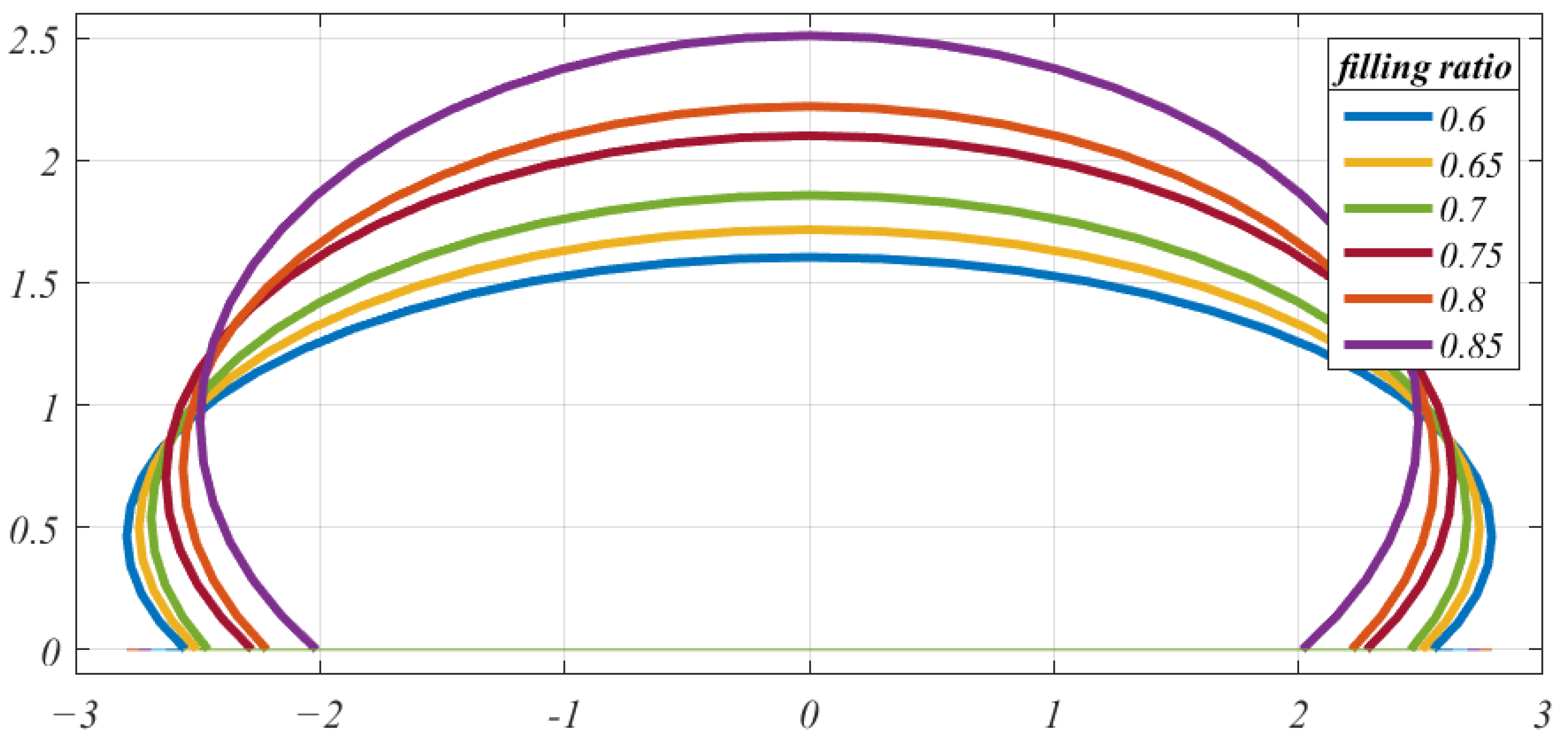



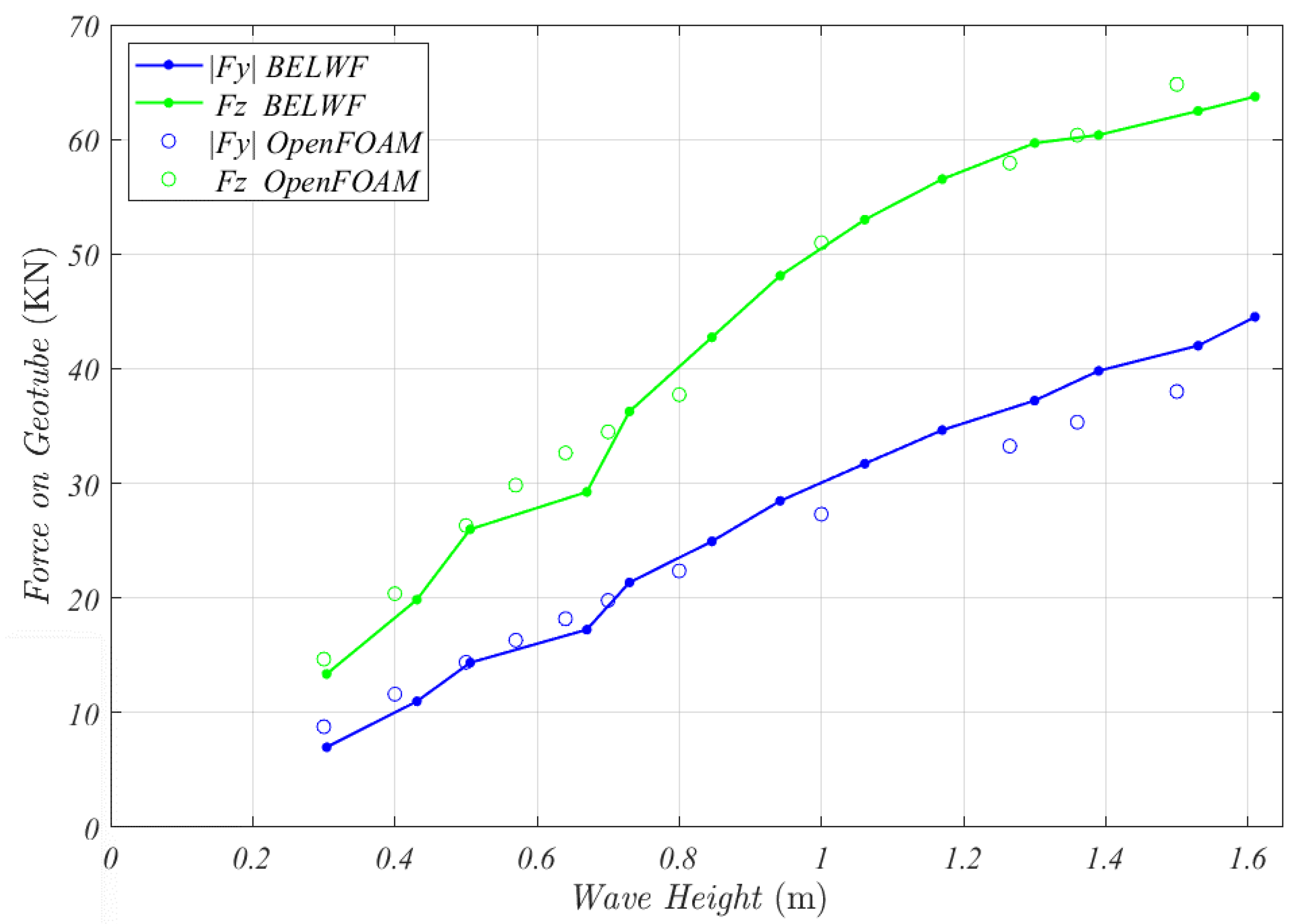


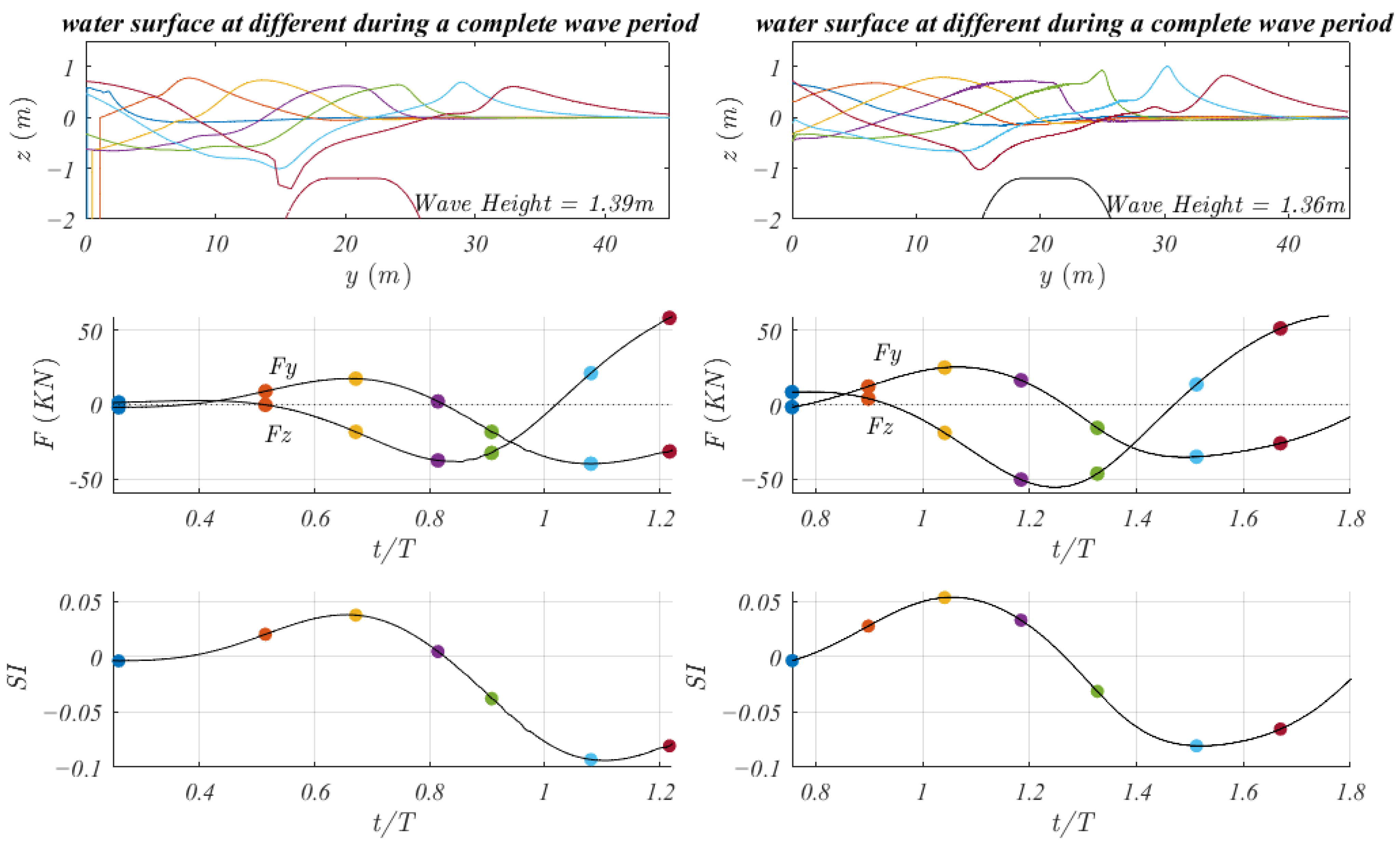


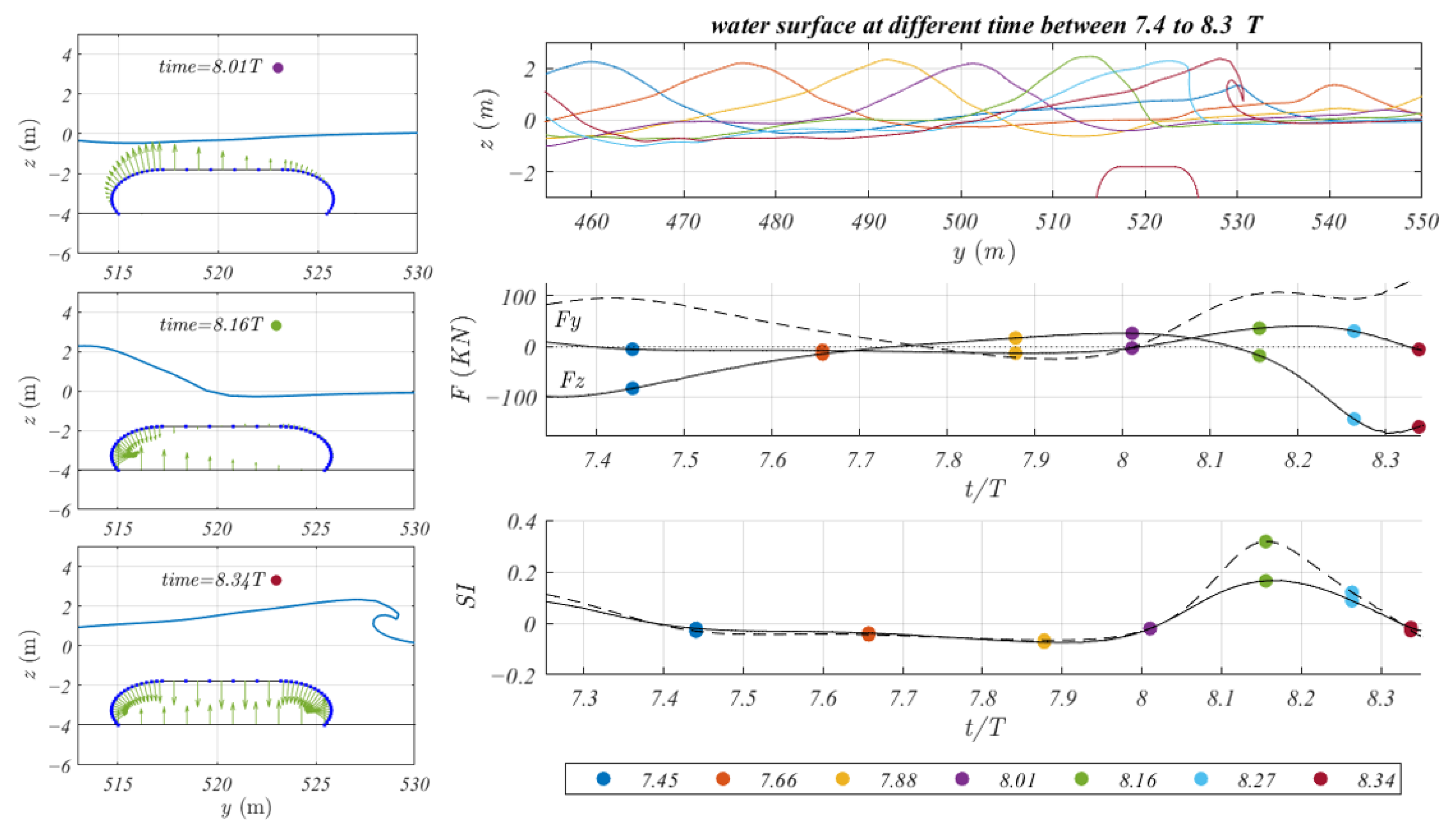
| Model | Maximum Number of Elements | Free Surface Elements Size | Number of Time Step in a Wave Period | Time Step | Maximum CFL * Allowed | Run Time per Wave Simulation |
|---|---|---|---|---|---|---|
| OpenFOAM | 207,777 | 00.2 × 0.15 × 0.1 m^3 to 0.01 × 0.01 × 0.01 m^3 | 140 to 26,900 | 0.005 s to 0.00026 s | 0.15 | 4–42 h On C2 |
| BELWF | 839 | 0.2 m to 0.4 m | 100 to 350 | 0.07 s to 0.02 s | 0.54 | 2–3 h On C3 |
Disclaimer/Publisher’s Note: The statements, opinions and data contained in all publications are solely those of the individual author(s) and contributor(s) and not of MDPI and/or the editor(s). MDPI and/or the editor(s) disclaim responsibility for any injury to people or property resulting from any ideas, methods, instructions or products referred to in the content. |
© 2023 by the authors. Licensee MDPI, Basel, Switzerland. This article is an open access article distributed under the terms and conditions of the Creative Commons Attribution (CC BY) license (https://creativecommons.org/licenses/by/4.0/).
Share and Cite
Bar, D.; Drimer, N. Preliminary Design Tools for Hydrodynamic Aspects of Submerged Impermeable Breakwaters. J. Mar. Sci. Eng. 2023, 11, 236. https://doi.org/10.3390/jmse11020236
Bar D, Drimer N. Preliminary Design Tools for Hydrodynamic Aspects of Submerged Impermeable Breakwaters. Journal of Marine Science and Engineering. 2023; 11(2):236. https://doi.org/10.3390/jmse11020236
Chicago/Turabian StyleBar, Daniel, and Nitai Drimer. 2023. "Preliminary Design Tools for Hydrodynamic Aspects of Submerged Impermeable Breakwaters" Journal of Marine Science and Engineering 11, no. 2: 236. https://doi.org/10.3390/jmse11020236
APA StyleBar, D., & Drimer, N. (2023). Preliminary Design Tools for Hydrodynamic Aspects of Submerged Impermeable Breakwaters. Journal of Marine Science and Engineering, 11(2), 236. https://doi.org/10.3390/jmse11020236






